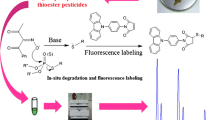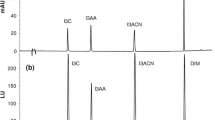Abstract
An effective method for the determination of 20 free amino acids in tea samples using 4-(carbazole-9-yl)-benzyl chloroformate (CBBC-Cl) as a derivatization reagent by high-performance liquid chromatography combined with fluorescence detection (HPLC-FLD) has been established. CBBC-Cl quickly derivatized amino acids within 6 min in basic solution (pH 9.0) at room temperature (ca. 25 °C). The maximum excitation and emission wavelengths of the stable derivatives were 290 nm and 370 nm, respectively. The separation of 20 amino acids, including the theanine (THE) derivative, was optimized on a Hypersil BDS-C18 column. Identification of these derivatives was performed via liquid chromatography/electrospray ionization mass spectrometry (LC/ESI/MS) in positive-ion detection mode. Under optimal conditions, excellent linearity for all the amino acids was obtained, with determination coefficients of r2 > 0.9986. The detection limits (LODs) and quantitation limits (LOQs) ranged from 0.13 to 1.5 μg·kg−1 and 0.43 to 4.95 μg·kg−1, respectively. Satisfactory recoveries, ranging from 86.7 to 106.4%, were obtained for all the amino acids in the tea samples. The developed method has been successfully applied to the quantification of 20 amino acids in tea samples.




Similar content being viewed by others
References
Chen Q, Zhao J, Fang C, Wang D (2007) Feasibility study on identification of green, black and Oolong teas using near-infrared reflectance spectroscopy based on support vector machine (SVM). Spectrochim Acta Mol Biomol Spectrosc 66(3):568–574
Zhao J, Chen Q, Huang X, Fang C (2006) Qualitative identification of tea categories by near infrared spectroscopy and support vector machine. J Pharm Biomed Anal 41(4):1198–1204
Zhu Y, Luo Y, Wang P, Zhao M, Li L, Hu X, Chen F (2016) Simultaneous determination of free amino acids in Pu-erh tea and their changes during fermentation. Food Chem 194:643–649
Lv H, Zhong Q, Lin Z, Wang L, Tan J, Guo L (2012) Aroma characterisation of Pu-erh tea using headspace-solid phase microextraction combined with GC/MS and GC–olfactometry. Food Chem 130(4):1074–1081
Yang C, Maliakal P, Meng X (2002) Inhibition of carcinogenesis by tea. Annu Rev Pharmacol Toxicol 42(1):25–54
Kuo K, Weng M, Chiang C, Tsai Y, Lin-Shiau S, Lin J (2005) Comparative studies on the hypolipidemic and growth suppressive effects of oolong, black, pu-erh, and green tea leaves in rats. J Agric Food Chem 53(2):480–489
Khan N, Mukhtar H (2007) Tea polyphenols for health promotion. Life Sci 81(7):519–533
Fujimura Y, Tachibana H, Yamada K (2004) Lipid raft-associated catechin suppresses the FcϵRI expression by inhibiting phosphorylation of the extracellular signal-regulated kinase1/2. FEBS Lett 556(1–3):204–210
Yashin A, Nemzer B, Combet E, Yashin Y (2015) Determination of the chemical composition of tea by chromatographic methods: a review. J Food Nutr Res 4(3):56–87
Fontana L, Cummings N, Apelo S, Neuman J, Kasza I, Schmidt B, Baar E (2016) creased consumption of branched-chain amino acids improves metabolic health. Cell Rep 16(2):520–530
Loto C (2011) Inhibition effect of tea (Camellia Sinensis) extract on the corrosion of mild steel in dilute sulphuric acid. J Mater Environ Sci 2(4):335–344
Syu K, Lin C, Huang H, Lin J (2008) Determination of theanine, GABA, and other amino acids in green, oolong, black, and Pu-erh teas with dabsylation and high-performance liquid chromatography. J Agric Food Chem 56(17):7637–7643
Vuong Q, Bowyer M, Roach P (2011) L-Theanine: properties, synthesis and isolation from tea. J Sci Food Agr 91(11):1931–1939
Kakuda T (2002) Neuroprotective effects of the green tea components theanine and catechins. Biol Pharm Bull 25(12):1513–1518
Nathan P, Lu K, Gray M, Oliver C (2006) The neuropharmacology of L-theanine (N-ethyl-L-glutamine) a possible neuroprotective and cognitive enhancing agent. J Herb Pharmacother 6(2):21–30
Sugiyama T, Sadzuka Y (1999) Combination of theanine with doxorubicin inhibits hepatic metastasis of M5076 ovarian sarcoma. Clin Cancer Res 5(2):413–416
Kato M, Gyoten Y, Sakai-Kato K, Toyooka T (2003) Rapid analysis of amino acids in Japanese green tea by microchip electrophoresis using plastic microchip and fluorescence detection. J Chromatogr A 1013(1–2):183–189
Hsieh M, Chen S (2007) Determination of amino acids in tea leaves and beverages using capillary electrophoresis with light-emitting diode-induced fluorescence detection. Talanta 73(2):326–331
Fiehn O (2008) Extending the breadth of metabolite profiling by gas chromatography coupled to mass spectrometry. TrAC Trend Anal Chem 27(3):261–269
Krumpochova P, Bruyneel B, Molenaar D, Koukou A, Wuhrer M, Niessen W, Giera M (2015) Amino acid analysis using chromatography–mass spectrometry: An inter platform comparison study. J Pharmaceut Biomed 114:398–407
Kambhampati S, Li J, Evan B, Allen D (2019) Accurate and efficient amino acid analysis for protein quantification using hydrophilic interaction chromatography coupled tandem mass spectrometry. Plant Methods 15(1):46
Yang W, Mirzaei H, Liu X, Regnier F (2006) Enhancement of amino acid detection and quantification by electrospray ionization mass spectrometry. Anal Chem 78(13):4702–4708
Tuberoso C, Congiu F, Serreli G, Mameli S (2015) Determination of dansylated amino acids and biogenic amines in Cannonau and Vermentino wines by HPLC-FLD. Food Chem 175:29–35
You J, Ming Y, Shi Y, Zhao X, Suo Y, Wang H, Sun J (2005) Development of a sensitive fluorescent derivatization reagent 1, 2-benzo-3, 4-dihydrocarbazole-9-ethyl chloroformate (BCEOC) and its application for determination of amino acids from seeds and bryophyte plants using high-performance liquid chromatography with fluorescence detection and identification with electrospray ionization mass spectrometry. Talanta 68(2):448–458
Thippeswamy R, Gouda K, Rao D, Martin A, Gowda L (2006) Determination of theanine in commercial tea by liquid chromatography with fluorescence and diode array ultraviolet detection. J Agric Food Chem 54(19):7014–7019
Fleury M, Ashley D (1983) High-performance liquid chromatographic analysis of amino acids in physiological fluids: on-line precolumn derivatization with o-phthaldialdehyde. Anal Biochem 133(2):330–335
López-Cervantes J, Sánchez-Machado D, Rosas-Rodríguez J (2006) Analysis of free amino acids in fermented shrimp waste by high-performance liquid chromatography. J Chromatogr A 1105(1–2):106–110
Björklund J, Einarsson S, Engström A, Grzegorczyk A, Becker H, Josefsson B (1998) Automated amino acid determination by high-performance liquid chromatography with 2-(9-anthryl) ethyl chloroformate as precolumn reagent. J Chromatogr A 798(1–2):1–8
Bosch L, Alegría A, Farré R (2006) Application of the 6-aminoquinolyl-N-hydroxysccinimidyl carbamate (AQC) reagent to the RP-HPLC determination of amino acids in infant foods. J Chromatogr B 831(1–2):176–183
Hernández-Orte P, Ibarz M, Cacho J, Ferreira V (2003) Amino acid determination in grape juices and wines by HPLC using a modification of the 6-aminoquinolyl-N-hydroxysuccinimidyl carbamate (AQC) method. Chromatographia 58(1–2):29–35
Yu Y, Li N, Jin Q, Ji Z, Sun Z, Li G, You J (2019) Novel fluorescence labeling reagent 4-(carbazole-9-yl)-benzyl chloroformate and its application in the determination of nitrofuran metabolites compounds in foodstuffs by high performance liquid chromatography with fluorescence detection. Microchem J 145:9–17
You J, Liu L, Zhao W, Zhao X, Suo Y, Wang H, Li Y (2007) Study of a new derivatizing reagent that improves the analysis of amino acids by HPLC with fluorescence detection: application to hydrolyzed rape bee pollen. Anal Bioanal Chem 387(8):2705–2718
You J, Shan Y, Zhen L, Zhang L, Zhang Y (2003) Determination of peptides and amino acids from wool and beer with sensitive fluorescent reagent 2-(9-carbazole)-ethyl chloroformate by reverse phase high-performance liquid chromotography and liquid chromotography mass spectrometry. Anal Biochem 313(1):17–27
Newcomb W, Deegan T, Miller W, Porco J Jr (1998) Analysis of 9-fluorenylmethoxycarbonyl (FMOC) loading of solid-phase synthesis resins by gas chromatography. Biotechnol Bioeng 61(1):55–60
Alcazar A, Ballesteros O, Jurado J, Pablos F, Martin M, Vilches J, Navalon A (2007) Differentiation of green, white, black, Oolong, and Pu-erh teas according to their free amino acids content. J Agric Food Chem 55(15):5960–5965
Mottram D, Wedzicha B, Dodson A (2002) Food Chem: acrylamide is formed in the Maillard reaction. Nature 419(6906):448
Gong J, Chen Y, Peng C, Zhou H (2010) Effect of different additives on the theabrownin and its formation mechanism during Pu-erh tea fermentation. J Tea Sci 30(2):101–108
Kovács Á, Simon-Sarkadi L, Ganzler K (1999) Determination of biogenic amines by capillary electrophoresis. J Chromatogr A 836(2):305–313
Strydom D, Tarr G, Pan Y, Paxton R (1992) Collaborative trial analyses of ABRF-91AAA. In Techniques in Protein Chemistry III. Academic Press. 261–274
Acknowledgements
This work was supported by National Natural Science Foundation of China (No. 21475075, 21677085 and 31801624) and the National Natural Science Foundation of Shandong Province (No. ZR2015CM040, ZR2017JL012, and ZR2018MC031).
Author information
Authors and Affiliations
Corresponding author
Ethics declarations
Conflicts of Interest
The authors declare that they have no conflict of interest.
Additional information
Publisher's Note
Springer Nature remains neutral with regard to jurisdictional claims in published maps and institutional affiliations.
Electronic supplementary material
Below is the link to the electronic supplementary material.
Rights and permissions
About this article
Cite this article
Wang, X., You, J., Sun, Z. et al. Using 4-(Carbazole-9-yl)-benzyl Chloroformate as a Derivatization Reagent for the Measurement of Amino Acids in Tea Samples by High-Performance Liquid Chromatography with Fluorescence Detection. Chromatographia 83, 487–496 (2020). https://doi.org/10.1007/s10337-020-03864-5
Received:
Revised:
Accepted:
Published:
Issue Date:
DOI: https://doi.org/10.1007/s10337-020-03864-5




